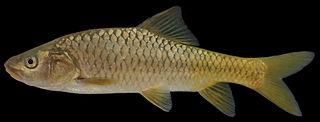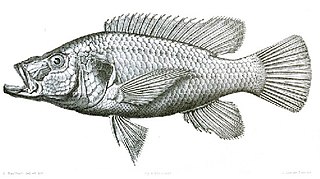
The red garra, also known as the doctor fish or nibble fish, is a species of cyprinid that is native to a wide range of freshwater habitats in subtropical parts of Western Asia. This small fish typically is up to about 14 centimeters in total length, but locally individuals can reach as much as 24 cm (9.5 in).
The desert pipistrelle is a species of vesper bat in the genus Hypsugo. It is found in Egypt, Israel, Jordan, Oman, Saudi Arabia, Sudan, and Yemen. Its natural habitats are subtropical or tropical dry shrubland, rocky areas, and hot deserts.

Günther's vole is a species of rodent in the family Cricetidae, also known by the name Levant vole. It is found in Bulgaria, Greece, Iran, Iraq, Israel, Jordan, Lebanon, North Macedonia, Serbia, Montenegro, Syria, Turkey, and Libya. In Libya, its natural habitats are temperate grassland, subtropical or tropical high-altitude grassland, and arable land. In Israel, it is common in lowland agricultural fields, in peak years becoming a major crop pest.

The bushy-tailed jird or bushy-tailed dipodil is a species of rodent in the family Muridae. It is the only species in the genus Sekeetamys. It is found in Egypt, Israel, Jordan, Saudi Arabia, and Sudan. Its natural habitat is rocky areas.
Acanthobrama lissneri, or the Jordan bream, is a species of freshwater fish in the family Cyprinidae. It is found in Israel and Jordan. Its natural habitats are rivers and lakes, and is now commonly found in reservoirs.

The Jordan himri is a ray-finned fish species in the family Cyprinidae.
The Jordan barbel is a species of ray-finned fish in the family Cyprinidae. It is found in Israel, Jordan, and Syria. Its natural habitats are rivers and freshwater lakes. It is threatened by habitat loss.

Garra barreimiae, the Oman garra, is a species of ray-finned fish in the family Cyprinidae. It is found in the mountains of northern Oman and in the United Arab Emirates. Most populations inhabit wadis, streams, pools and springs, but one population which lives in a cave system, is known as Omani blind cave fish, and has lost its sight and pigmentation. The only other cave fish in the Arabian Peninsula is the Tawi Atair garra, but it has normal eyes.

Garra is a genus of fish in the family Cyprinidae. These fish are one example of the "log suckers", sucker-mouthed barbs and other cyprinids commonly kept in aquaria to keep down algae. The doctor fish of Anatolia and the Middle East belongs in this genus. The majority of the more than 160 species of garras are native to Asia, but about one-fifth of the species are from Africa.
Garra kemali is a species of cyprinid fish, which is found only in Turkey, in swamps and freshwater lakes. It is threatened by a habitat loss.
Garra nana is a ray-finned fish species in the family Cyprinidae. It is found in Israel, Jordan and Syria. Its natural habitats are freshwater rivers, lakes and ponds of the Barada and Jordan River drainage basins, as well as the Kishon River. This bottom-dwelling fish is often overlooked, as it is small and prefers to hide among stones and water plants. It is an omnivore which feeds on aufwuchs. The species was previously placed in the genus Hemigrammocapoeta. It reaches up to 12 cm (4.7 in) in total length.

Oxynoemacheilus insignis is a species of stone loach It is restricted to the Damascus basin in Syria and to the Jordan-Dead Sea basin in Syria, Israel and Jordan. Its natural habitat is rivers. It is threatened by the drying up of the rivers and streams in which it is found, caused by overuse, damming and less rainfall, as well as by pollution. In Syria it has been extirpated from the Barada and can now only be found in the upper reaches of the Awaj to the west of Damascus. It is a highly variable species and different populations can differ from their neighbouring populations that in the past they have been described as species or subspecies and this has led to a large number of synonyms for Oxynoemacheilus insignis.
Typhlogarra widdowsoni or Garra widdowsoni, the Iraq blind barb or Haditha cave garra, is a species of cyprinid fish endemic to underground water systems near Haditha in Iraq. Although traditionally placed in its own genus Typhlogarra, this is not supported by genetic evidence, leading to its move to Garra. This cavefish is considered critically endangered because of water extraction, which has lowered the groundwater level. Once abundant, a survey in 2012 found that it now was very rare. Another species from the same place, Caecocypris basimi, may already be extinct. The only other known cavefish in Iraq is Eidinemacheilus proudlovei.
Acanthodactylus ahmaddisii, also known commonly as the Jordanian fringe-fingered lizard, is a species of lizard in the family Lacertidae.

Tristramella sacra, the long jaw tristramella, is a species of cichlid fish that was endemic to the Sea of Galilee in Israel. It has not been recorded since 1990, despite searches both of the lake and in local markets, and it is regarded as extinct by the IUCN. This species could reach a total length of up to 28 cm (11 in).

Cavefish or cave fish is a generic term for fresh and brackish water fish adapted to life in caves and other underground habitats. Related terms are subterranean fish, troglomorphic fish, troglobitic fish, stygobitic fish, phreatic fish, and hypogean fish.

Garra ceylonensis is a species of ray-finned fish in the cyprinid family. It is endemic to rivers and streams in Sri Lanka - and is considered as a schooling fish. It is a rheophilic species and occurs in slow to moderately flowing rivers and streams, and ascends small, rocky streams in order to breed. It primarily feeds on aufwuchs - algae and diatoms.
Garra hughi is an endangered species of ray-finned fish in the genus Garra. It occurs in high mountain streams of the Southern Western Ghats, from the Anamalai Hills, south to the Agasthyamala Hills. The species is a benthopelagic fish, found in mountain streams.

Garra surendranathanii is a species of ray-finned fish in the genus Garra from the Western Ghats in Kerala. It occurs on four river systems the Periyar, Chalakudy, Pamba and Achenkovil in the state. A decline in habitat quality has endangered this fish.
Garra tibanica is a species of ray-finned fish in the genus Garra.










